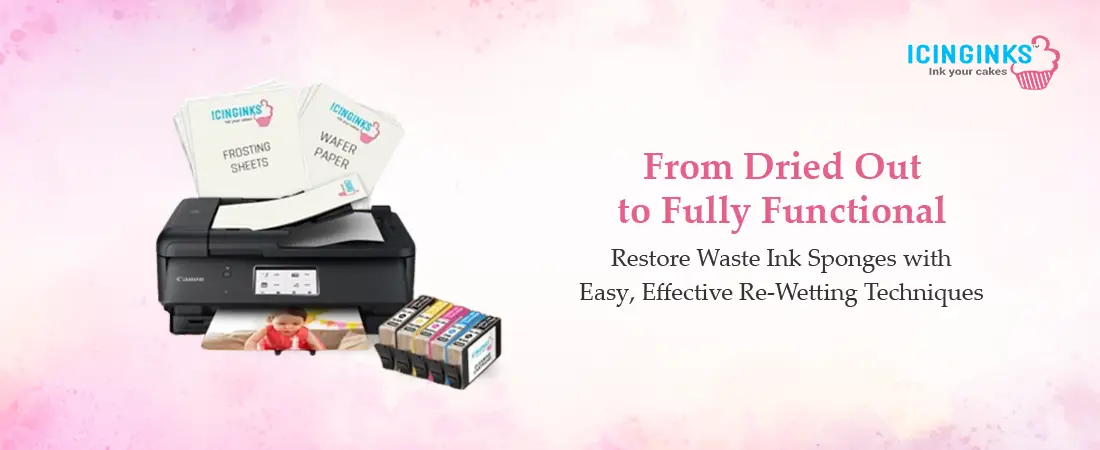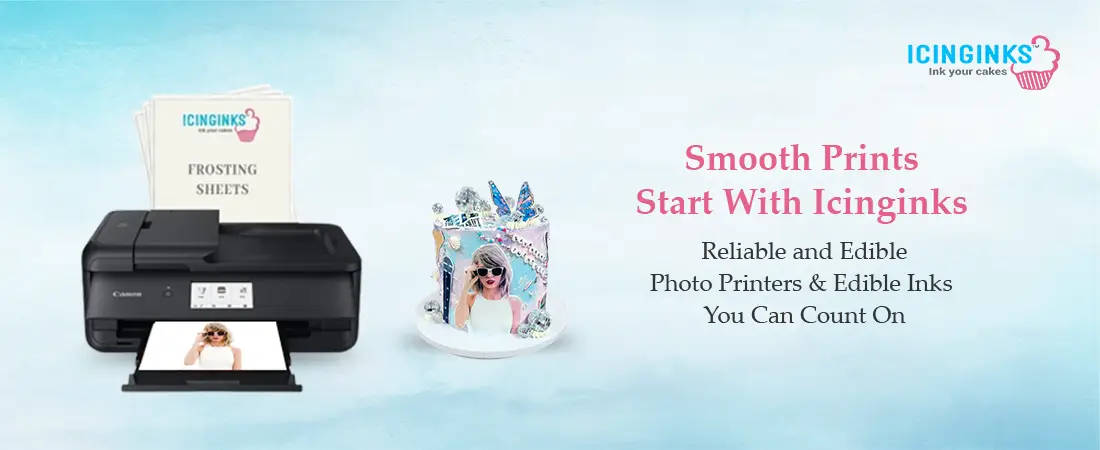
If your edible photo printer has been sitting idle long enough to grow dust bunnies, there’s a good chance it’s hiding a bigger issue-dry waste ink sponges quietly clogging up your creative potential.
In the world of edible ink printing, dry waste ink sponges are a hidden villain. Over time, these tiny but mighty sponge blocks inside your printer get saturated and eventually dry out, especially when the printer isn't used frequently. But don't worry! You don’t need to replace your printer or spend a fortune on repairs. With clever, easy-to-do techniques, you can bring those dry waste ink sponges back to life and keep your edible creations flowing beautifully.
Let’s dive in.
What Exactly Are Waste Ink Sponges?
Inside every edible photo printer, a mechanism catches and holds the extra edible ink expelled during cleaning cycles or nozzle purges. These pads, known as waste ink sponges, absorb this ink to prevent it from leaking inside the machine.
However, over time-and especially when the printer isn’t used regularly-they dry out and harden. When that happens, they stop effectively absorbing ink, leading to overflow warnings, streaky prints, or permanent damage to your device.
Why It Matters More for Edible Printing
Unlike traditional printers, edible photo printers use specialized food-grade ink. Edible ink tends to be thicker and dries faster, especially if the printer is idle for too long. This accelerates the drying of waste ink sponges and makes regular maintenance essential for bakers, pastry chefs, and edible artists.
If you’re using your printer seasonally-for custom cakes, cookies, or party treats-it’s even more important to monitor these internal parts.
Warning Signs Your Sponges Are in Trouble
Not sure if you're dealing with sponge-related issues? Keep an eye out for these red flags:
- Ink smudges or streaks on edible paper
- Frequent cleaning cycle prompts
- Error messages despite full cartridges
- Poor print quality with fading colors
- Strange noises during the purge or startup
These subtle hints often point to waste ink sponges losing their ability to absorb effectively.
The Tools You’ll Need for Rehydration
Bringing dried sponge pads back to life is simpler than it sounds. Here's what you’ll need:
- Distilled water – avoids mineral deposits
- Isopropyl alcohol (90% or higher) – helps break down dried ink
- A syringe or dropper – for controlled liquid application
- Lint-free cloth or paper towels – for blotting
- Screwdriver – if you need to access the sponge area
- Gloves – to keep things clean and food-safe
This method is safe for your printer, workspace, and edible projects.
Step-by-Step: How to Re-Wet Waste Ink Sponges
Follow this method carefully to rehydrate and restore your printer's functionality:
1. Power Off and Unplug
Never work on your edible photo printer while it's on. Disconnect it from the power source completely.
2. Locate the Sponge Pads
You can find the sponge area by referring to your printer manual or model-specific guide. It is usually located near the purge station or under the printhead bay.
3. Prepare the Cleaning Solution
Mix distilled water with 1 part isopropyl alcohol in a clean container.
4. Apply Gently
Use the syringe to inject the solution slowly into the waste ink sponges. Don’t flood them-just enough to dampen and soften the dried edible ink.
5. Let it Soak
Allow the mixture to sit for 10–15 minutes. The sponge will darken as it reabsorbs moisture.
6. Blot Carefully
Use a paper towel or lint-free cloth to gently press the sponge area and draw out excess fluid and broken-down ink residue.
7. Air Dry
Let the printer sit uncovered for a few hours before powering it on again. This ensures no moisture interferes with the circuitry.
Maintenance Tips to Avoid Dry Sponges
Once your waste ink sponges are revived, follow these preventative care steps to keep them in top shape:
- Print weekly-even a small image will keep edible ink flowing
- Use your printer’s built-in maintenance cycle monthly
- Store it in a cool, dry place away from direct sunlight
- Cover your printer when not in use to avoid dust accumulation
- Use high-quality edible ink to prevent clogging or gumming
Avoiding prolonged inactivity is key. Your printer will thank you with smoother, cleaner prints every time.
When DIY Isn’t Enough
Sometimes, sponge pads reach the point of no return. If your waste ink sponges remain unresponsive after multiple rehydration attempts, consider the following:
- Replace the sponges manually – sponge kits are available online
- Install an external waste ink tank – popular among frequent users
- Seek professional service – especially if you’re unsure of disassembly
Edible printers are an investment, and proper maintenance extends their lifespan significantly.
How Waste Sponges Impact Edible Printing
So, how does all of this affect your edible masterpiece?
Your printer can't maintain pressure balance when waste ink sponges are dried or blocked. That means streaks, blotches, or even complete failure to print. And there's no room for errors when your canvas is a delicate sugar sheet or frosting paper.
Even with the best edible ink cartridges and top-quality frosting sheets, neglected sponge pads can ruin a perfect cake topper or photo cookie.
Using Edible Ink Responsibly
Alongside sponge maintenance, make sure you're using edible ink properly:
- Check expiration dates – expired ink thickens faster
- Shake before use – prevents pigment separation
- Store in cool, dark places – to extend shelf life
- Use compatible cartridges – to reduce waste and printer errors
Clean ink leads to clean prints, and when food is involved, cleanliness is non-negotiable.
Conclusion: A Little Effort Goes a Long Way
While they may seem insignificant, waste ink sponges are essential to the smooth functioning of your edible photo printer. Ignoring them can result in costly replacements and missed orders-but with a little care and the right approach, you can keep them in great condition for years.
Rewetting is easy, inexpensive, and effective. Whether you're a professional baker or a passionate hobbyist, restoring your printer’s sponge system helps you produce beautiful, hygienic, and flawless edible art every single time.
So, the next time your prints come out faint, blotchy, or incomplete, you’ll know what to check and how to fix them.
Keep Your Prints-and Sponges-Running Smooth with Icinginks

Owning an edible photo printer involves dealing with waste ink sponges, but starting with reliable, high-quality equipment makes maintenance a breeze. At Icinginks, our printers are engineered specifically for edible printing, ensuring smoother operation and fewer clogs right out of the box.
Paired with our premium edible ink, you’ll experience cleaner flow, better absorption, and less sponge saturation-helping you avoid unnecessary buildup and keep those crucial internal components functioning longer.
Whether you're printing cake toppers, cookies, or chocolate designs, Icinginks gives you vibrant, food-safe results without the printer headaches.
Explore our range of edible photo printers and edible inks at Icinginks.com!
FAQs
1. What are waste ink sponges in a printer?
Waste ink sponges are absorbent pads inside printers that collect excess ink during cleaning or printing cycles. Over time, they become saturated, affecting printer performance. Keeping these sponges clean or re-wetted in edible photo printers ensures consistent edible ink flow and helps prevent clogging or poor-quality prints.
2. Can waste ink sponges be reused after drying out?
Yes, waste ink sponges can often be revived using simple re-wetting techniques. Soaking them in warm, distilled water and gently pressing out dried edible ink helps restore absorbency. This extends the sponge's lifespan and reduces waste and printer maintenance costs for edible printing tasks.
3. Why do waste ink sponges dry out in edible photo printers?
Waste ink sponges dry out due to frequent cleaning cycles, infrequent printer use, or exposure to air. Since edible ink contains food-grade ingredients, it may dry or thicken faster than standard ink. Maintaining humidity and running occasional test prints is important to keep the system moist.
4. How do re-wetting techniques help prolong printer life?
Re-wetting dried waste ink sponges helps maintain proper ink absorption and flow. This reduces strain on printheads and internal components, especially in edible photo printers where ink consistency is critical. Reviving the sponge improves overall efficiency, minimizes errors, and extends your printer’s performance without costly replacements.
5. Is edible ink safe to handle while cleaning waste ink sponges?
Yes, edible ink is made from food-safe ingredients, making it safer than traditional ink. However, wearing gloves while cleaning waste ink sponges is still advisable to avoid staining and maintain hygiene-especially if the same printer is used for commercial edible printing.
Related Post:
Selecting the Right Edible Ink for Your Cake Decorating
5 Innovative Ways To Use Edible Ink
Edible Ink Safety: What You Need to Know Before Decorating




